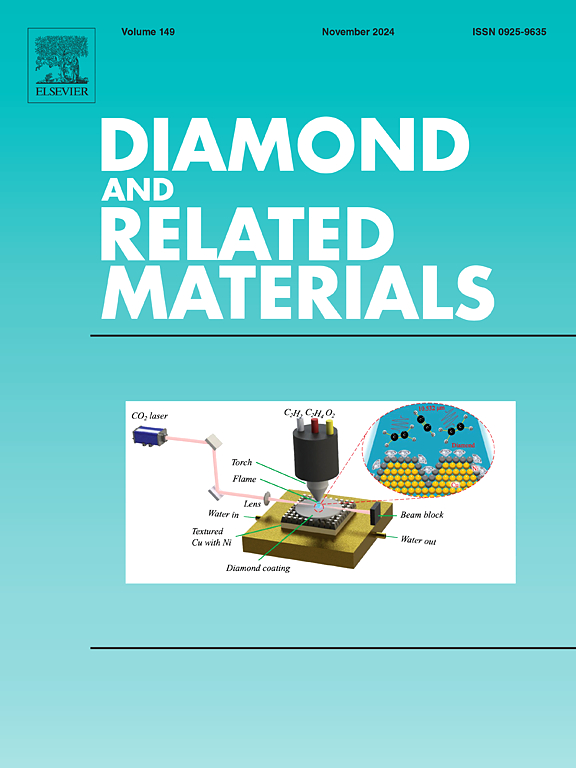单晶AlN紫外光催化化学机械抛光工艺参数研究
IF 4.3
3区 材料科学
Q2 MATERIALS SCIENCE, COATINGS & FILMS
引用次数: 0
摘要
单晶氮化铝(AlN)具有宽带隙和高导热性,是一种很有前途的第三代半导体材料。然而,单晶AlN的特点是其硬度,良好的耐磨性和化学惰性,这些共同提出了实现高效率和高质量抛光的重大挑战。本文主要研究了基于紫外光催化的化学机械抛光技术对单晶AlN的加工。本研究探讨了H2O2浓度、TiO2浓度、光照强度等反应参数对OH浓度的影响。此外,通过单因素抛光实验,研究了化学反应参数(H2O2浓度、TiO2浓度、光照强度、光照方式)和机械工艺参数(磨料粒度、磨料浓度、抛光压力、抛光垫速度)对单晶AlN加工的影响及其抛光机理。研究结果表明,单晶AlN的材料去除率(MRR)与OH浓度之间存在很强的相关性,随着H2O2浓度、TiO2浓度和光照强度的增加,两者均呈现先增加后降低的趋势。增大磨料粒度、磨料浓度、抛光压力和抛光垫速度均能提高单晶AlN的材料去除率。随着H2O2浓度、TiO2浓度、光强、磨料粒度、磨料浓度、抛光压力和抛光垫速度的增大,AlN单晶表面粗糙度先减小后增大。在紫外光催化反应中,AlN与OH或H2O反应形成腐蚀层(Al2O3, AlOOH和Al(OH)3),然后被磨料的机械作用除去,暴露出新的单晶AlN表面,在其上继续发生腐蚀和机械去除。本文为紫外光催化技术在单晶AlN抛光领域的应用提供了更多的依据。本文章由计算机程序翻译,如有差异,请以英文原文为准。

Study on the process parameters of UV photocatalytic chemical mechanical polishing for single-crystal AlN
Single-crystal aluminum nitride (AlN) has a wide band gap and high thermal conductivity, and is a promising 3th generation semiconductor material. However, single-crystal AlN is characterised by its hardness, good wear resistance and chemical inertness, which collectively present significant challenges in achieving both high efficiency and high-quality polishing. In this paper, the focus is on the processing of single-crystal AlN using chemical mechanical polishing based on UV photocatalysis. The study explores the influence of reaction parameters, including H2O2 concentration, TiO2 concentration, and light intensity, on the concentration of ![]() OH. Furthermore, the influence of chemical reaction parameters (H2O2 concentration, TiO2 concentration, light intensity, lighting methods) and mechanical process parameters (abrasive grain size, abrasive concentration, polishing pressure, polishing pad speed) on the processing of single-crystal AlN and the polishing mechanism were studied through single-factor polishing experiments. The findings indicate a robust correlation between the material removal rate (MRR) of single-crystal AlN and the concentration of
OH. Furthermore, the influence of chemical reaction parameters (H2O2 concentration, TiO2 concentration, light intensity, lighting methods) and mechanical process parameters (abrasive grain size, abrasive concentration, polishing pressure, polishing pad speed) on the processing of single-crystal AlN and the polishing mechanism were studied through single-factor polishing experiments. The findings indicate a robust correlation between the material removal rate (MRR) of single-crystal AlN and the concentration of ![]() OH, with both exhibiting an initial increase followed by a subsequent decrease in response to increasing H2O2 concentration, TiO2 concentration, and light intensity. The material removal rate of single-crystal AlN is increased by increasing the abrasive grain size, abrasive concentration, polishing pressure and polishing pad speed. As the H2O2 concentration, TiO2 concentration, light intensity, abrasive grain size, abrasive concentration, polishing pressure and polishing pad speed increased, the surface roughness of single-crystal AlN first decreased and then increased. In the UV photocatalytic reaction, AlN reacts with
OH, with both exhibiting an initial increase followed by a subsequent decrease in response to increasing H2O2 concentration, TiO2 concentration, and light intensity. The material removal rate of single-crystal AlN is increased by increasing the abrasive grain size, abrasive concentration, polishing pressure and polishing pad speed. As the H2O2 concentration, TiO2 concentration, light intensity, abrasive grain size, abrasive concentration, polishing pressure and polishing pad speed increased, the surface roughness of single-crystal AlN first decreased and then increased. In the UV photocatalytic reaction, AlN reacts with ![]() OH or H2O to form a corrosion layer (Al2O3, AlOOH and Al(OH)3), which is then removed by the mechanical action of the abrasive, exposing a new single-crystal AlN surface on which corrosion and mechanical removal continue to occur. This paper provides more evidence for the application of UV photocatalytic technology in the field of single-crystal AlN polishing.
OH or H2O to form a corrosion layer (Al2O3, AlOOH and Al(OH)3), which is then removed by the mechanical action of the abrasive, exposing a new single-crystal AlN surface on which corrosion and mechanical removal continue to occur. This paper provides more evidence for the application of UV photocatalytic technology in the field of single-crystal AlN polishing.
求助全文
通过发布文献求助,成功后即可免费获取论文全文。
去求助
来源期刊

Diamond and Related Materials
工程技术-材料科学:综合
CiteScore
6.00
自引率
14.60%
发文量
702
审稿时长
2.1 months
期刊介绍:
DRM is a leading international journal that publishes new fundamental and applied research on all forms of diamond, the integration of diamond with other advanced materials and development of technologies exploiting diamond. The synthesis, characterization and processing of single crystal diamond, polycrystalline films, nanodiamond powders and heterostructures with other advanced materials are encouraged topics for technical and review articles. In addition to diamond, the journal publishes manuscripts on the synthesis, characterization and application of other related materials including diamond-like carbons, carbon nanotubes, graphene, and boron and carbon nitrides. Articles are sought on the chemical functionalization of diamond and related materials as well as their use in electrochemistry, energy storage and conversion, chemical and biological sensing, imaging, thermal management, photonic and quantum applications, electron emission and electronic devices.
The International Conference on Diamond and Carbon Materials has evolved into the largest and most well attended forum in the field of diamond, providing a forum to showcase the latest results in the science and technology of diamond and other carbon materials such as carbon nanotubes, graphene, and diamond-like carbon. Run annually in association with Diamond and Related Materials the conference provides junior and established researchers the opportunity to exchange the latest results ranging from fundamental physical and chemical concepts to applied research focusing on the next generation carbon-based devices.
 求助内容:
求助内容: 应助结果提醒方式:
应助结果提醒方式:


